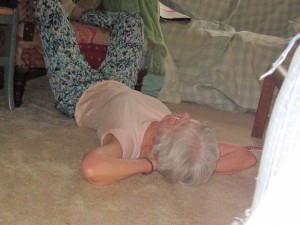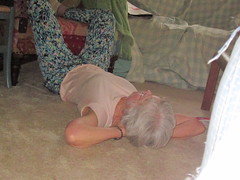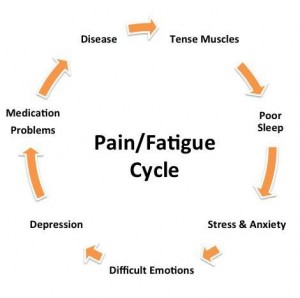Gentle Reader,
Confessions of an arthritic painting contractor:
Taking down paintings, emptying book shelves, moving furniture, rolling up rugs, pulling up old wall-to-wall carpet, removing electric face-plates and then spackling, sanding, taping, and painting every wall that faces the outside is a sure-fire recipe for arthritic flare-ups of major proportion. No matter how many times I lay down on the floor and hung my knees over the Back2Life machine; no matter how many of Shaklee’s herbal Pain Relief Complex tablets I took, I could not prevent pain from coming on.
The people I was supervising as general painting contractor were:
Carsten Rossen and Jack Dahlstrom, 14 and 16, grandsons who did major lifting and prep work and even some priming.
Hanna Rossen and Ben Killorin, 17 and 19, grandchildren who turned out to be excellent painters and were able to mask, spackle, sand, edge and roll paint with only a few drips here and there. They each put in hours of time, their music blasting, bags of gorp and dried mangos, enormous sandwiches and Shaklee Performance drink for rehydration consumed. Ben made the sandwiches as his first summer job was the Deli department at a local grocery store.
Elizabeth Skewis, friend of Grace, my oldest daughter, and now a great friend of mine, is a woman who has done everything under the sun for a living including painting. She was my right hand gal, with skill and stick-to-itiveness, esthetic judgment and coaching for me and the teenagers.
Pete Rossen and Hanna, father and daughter, came to move the furniture back where it belonged after the final (almost final) painting was done. He was the one who suggested I could hire my grandchildren when I was fretting about whom to get to do the painting. I loved their youthful energy in the house and their “there, there, Grandma. Don’t lift anything. Just tell us and we’ll do it.”
Mike Walker, my renter who lives down stairs and is a finish carpenter. He put all the running toe board back in every room with his power tools.
The problem child in this final stage of the energy upgrade was, you guessed it, ME. I love hard work and couldn’t stop myself from all the above mentioned tasks. I did stop lifting.
Two observations that may help you who suffer from arthritis when you are over-active.
1. Don’t stop moving. In the middle of this ordeal I took a 3 ½ mile neighborhood walk which included a long downhill, then a beach walk and finally a 190 tread staircase and 4 long blocks uphill. Moving keeps the nutrients flowing to the joints which are poorly nourished. Without good nutrition, the crumbling joint cannot heal itself. Which brings me to the second point:
2. The cells in our joints are constantly repairing and rebuilding new, healthy cells to replace the worn out ones and to solve the problems of collapsing vertebrae. Peggy Cappy talks about this in her meditative CD “Healing Back Pain” which I listen to nearly every day. Wednesday, after hiking 9 miles round trip, 2000+ ft elevation gain, on Mt. Rainier’s east side to Summerland alpine meadow, I stopped for the evening with one of my hiking buddies. Her husband is a neurologist with Group Health here in Seattle. In our conversation he stated that these broken down joint cells do get replaced with fresh, healthy new cells that attempt to fix the problems. He has told me many times to keep moving, no matter what. Find something to do that doesn’t hurt and keep doing it.
Today, I spent the morning hanging pictures and scrubbing pain spots off the hard wood floors. I have no pain.
You can build healthy joints, but you must keep moving to help your body accomplish that feat.
The house is beautiful. It was all worth it. Here’s a video I put together to show the energy upgrade work that was done. When you see the space age water heater, you’ll appreciate the remark made by the city inspector when he came to sign off on the stepped-up electrical power,
“Wow. This thing should be in the living room where you can sit with your friends, smoke a joint and watch it.”
Whoa!
May I offer a further explanation of the energy improvements under the new roof. The Crown Roofing guys took off the old stuff including the particle board and before they put the new base and shingles on, the Vesta Performance guys laid down rigid insulation covered by a thin layer of reflective material which would further divert summer heat from entering the house. They also installed a fan system circulating air in the summer and avoiding mold build-up from a poorly ventilated crawl space over the ceiling and under the roof. I desperately needed a new roof and was able to fold the cost of the roof itself into the energy upgrade low-interest loan from the Puget Sound Community Credit Union. This banking institution works with the city of Seattle to implement the Community Power Works program for the homeowner who wants to lower their carbon foot print. A new roof by itself may or may not reduce heat loss from your house.
You are welcome to drop by and tour the garage and I’ll offer you a cold drink of some sort, but mostly you won’t notice anything different about the house. It does look fresh and clean but I didn’t change the colors or the furniture. If you are a person who notices roofs (is there such a person?), you’ll see that mine is beautiful, new and no places where the shingles have flown off in the latest wind storm. But who looks at roofs?
I am so proud to have done this major effort to reduce my carbon foot print as part of Seattle Community Power Works. The final numbers came through in the blow test today. Looking good. One tight house. It’s for the Planet and the grandchildren. I hope you’ll take advantage of any opportunity you have to do the same. Congratulations if you already have.
Leave me a comment and while you are at it, please ‘like’ my Face book page. I’d appreciate it.
Be well, Do well and Keep Moving,
Betsy
206 933 1889




 but get too busy at the desk to do them when you get back home. Then suddenly the pain shows up. I do know what to do:
but get too busy at the desk to do them when you get back home. Then suddenly the pain shows up. I do know what to do: Madame Tussaud’s wax museum is a history/pop culture lesson. For her, American giants from George Washington and Lincoln to the Obama’s came alive. For me, she introduced me to the TV stars, singers and comedians who perform today (and I never watch).
Madame Tussaud’s wax museum is a history/pop culture lesson. For her, American giants from George Washington and Lincoln to the Obama’s came alive. For me, she introduced me to the TV stars, singers and comedians who perform today (and I never watch).

 weather was wonderful for strolling. Probably the most exciting thing Ellie did was make a Muppet at FAO Schwartz.
weather was wonderful for strolling. Probably the most exciting thing Ellie did was make a Muppet at FAO Schwartz.
 depicted in Judy Chicago’s famous Dinner Party. On our last day there we went out to Saint John the Devine. Blue-gowned graduates of Columbia Teachers’ College were just leaving the Cathedral and their ceremony. Proud parents and grand parents took pictures as we sat on the steps. Later when I asked Ellie if she would ever come back to New York, she said maybe she’d go there to college.
depicted in Judy Chicago’s famous Dinner Party. On our last day there we went out to Saint John the Devine. Blue-gowned graduates of Columbia Teachers’ College were just leaving the Cathedral and their ceremony. Proud parents and grand parents took pictures as we sat on the steps. Later when I asked Ellie if she would ever come back to New York, she said maybe she’d go there to college.


